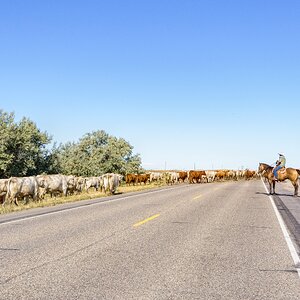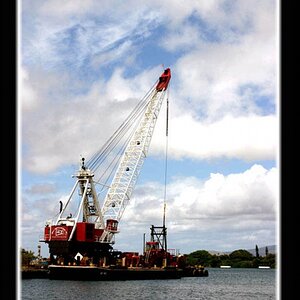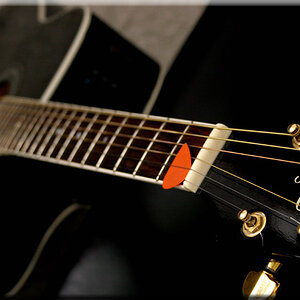TCampbell
Been spending a lot of time on here!
- Joined
- Mar 31, 2012
- Messages
- 3,614
- Reaction score
- 1,556
- Location
- Dearborn, MI
- Can others edit my Photos
- Photos OK to edit
The iPhone is dirt-simple to use -- there's no denying that. And... considering how tiny it is, the image quality is frankly amazing (for a phone anyway).
There are a few really big things that a DSLR will do that no phone camera can match.
1) Focus and shooting speed: A DSLR has a dedicated array of focusing sensor which are very smart. Any camera using "live view" type shooting (you see the shot on the screen before you take it ... like a phone or even most point & shoot cameras) has to "guess" their way to better focus. They search for edges that should be sharp and analyze the contrast difference along the edge. They change the focus and resample to see if the image got better or worse, and they have to iterate through a few times to optimize focus. That takes a while and causes a delay from the moment you want to shoot until the moment the shot is captured.
A DSLR doesn't use the image sensor. It uses a dedicated focusing system. Light passes through a beam splitter (a prism) and splits into "phases". It's like taking a pair of scissors and slicing a photograph into two halves and then sliding them so the two halves don't quite line up neatly. Based on focus distance, the two "phases" of the image will actually converge. That's not the magic part. The magic part is that the camera can analyze all focus points instantly. Based on the direction of the mis-alignment, it can instantly determine if the image is in focus or out of focus AND can tell if it needs to focus in closer or out farther to bring the image into focus AND it knows EXACTY HOW MUCH it needs to change focus. This makes the focus systems VERY fast. Assuming the camera has enough light to use for focus (and some cameras have focus-assist beams either in-canera or on external flash to give it a focusing pattern even when there isn't enough light) the speed of focus is pretty much limited to how fast the focus motors can move the lens (and some lenses are really fast.)
BTW, the above is true of the vast majority of DSLR cameras but there are some new technologies which create a few exceptions but I won't go into those here.
2) You can change lenses. This might not seem like a big deal... but it is. Camera phones tend to take shots where everything is more or less in focus. In the out of focus areas aren't that far out of focus. By changing lenses you can change all kinds of physics about how light behaves. You can create tack-sharp subjects with beautifully de-focused backgrounds (not just any lens can do this).
3) You can employ auxiliary lighting and off-camera lighting and use lighting modifiers. DSLR cameras are designed with the ability to use external lighting. Lighting has a more dramatic effect on imagery than lens choice. Camera phones can't use external lighting ... nor can the majority of point & shoot cameras.
That's the good news.
The bad news is that the camera is bulkier (there's no getting around that) and also because the camera is just a tool and not actually magic, getting the best results means investing some time into learning to exploit the capabilities of the camera as a tool and not just letting the camera use automatic mode ("automatic" tends to try to use "safe" exposures that will hopefully get something most of the time even if a different exposure would have done a much better job.)
Cameras
Canon and Nikon put their options into a few categories.
There's generally a low entry-range, a high entry-range, a mid-range, and some pro-range choices. We'll leave out the mid and pro range bodies due to budget. This leaves you with low entry-range and high entry-range.
Canon's low entry-range bodies are easy to identify because the model does not have a small letter "i" as the suffix in the model name. For example the T5 is currently the newest offering in Canon's low entry-range. But this is more recently introduced product because prior to that, the T3 was their low entry-range product.
For Nikon, the low entry-range bodies have a "D" followed by a 4 digit number that starts with a 3. E.g. D3000, D3100, D3200, D3300. The most recently introduced body is the D3300 but you can still get the D3200 and D3100.
Canon's high entry-range bodies add the "i" suffix to the model name. E.g. the Canon EOS Rebel T5i is the newest and highest of the "entry" range bodies. But the T3i is still marketed.
Nikon's high entry-range bodies follow low entry-range pattern but change the "3" to a "5". E.g. D5300, D5200, and D5100. The D5300 is the latest / most-recently introduced.
Canon does have one camera which is entry-range but in it's own little category. They make a model called the EOS Rebel SL1. The SL1's big feature is it's compact size. It's a true DSLR camera and uses the same EOS system as every other DSLR, but Canon tried to make the body as small as possible and STILL have room for the same size sensor and the reflex mirror. This camera is better than their low entry-range cameras, but not quite as good as the high entry-range bodies... but in a smaller physical body size. There are no differences in terms of sensor resolution and image quality.
You will need at least one lens. It's possible to buy a camera in a "body only" configuration but this assumes you either already own other compatible lenses or you just want to choose a lens other than the lens they normally offer in the "kit". The "kit" lens for virtually all of these cameras is an 18-55mm zoom lens. This offers wide-angle through a very modest telephoto strength. It's intended to be low cost and get you started. Both companies have lens lineups of somewhere around 75 lenses available PLUS a vast array of 3rd party companies that also make compatible lenses.
A body+lens kit will include everything you need to get started EXCEPT a memory card (you will need one of those.)
With all of that said, your other half might just not want a DSLR camera. Some people really prefer using a camera phone. My other half will ONLY use his iPhone. What's interesting is not that he thinks his phone is better... he knows it's not as good. He just doesn't want to take the time to learn how to use a DSLR because he views it as "complicated" (btw, all these cameras have a fully automatic mode that's dirt-simple to use and you can safely ignore every other button on the camera body. BUT... you'll get much better results if you take the time to learn "what else" the camera can do if you take it out of automatic mode.) So anytime my other half wants a higher quality photo, he'll tell me to bring my camera.
Hopefully your other half is on-board with this idea or you may be purchasing an $800 paper weight.
There are a few really big things that a DSLR will do that no phone camera can match.
1) Focus and shooting speed: A DSLR has a dedicated array of focusing sensor which are very smart. Any camera using "live view" type shooting (you see the shot on the screen before you take it ... like a phone or even most point & shoot cameras) has to "guess" their way to better focus. They search for edges that should be sharp and analyze the contrast difference along the edge. They change the focus and resample to see if the image got better or worse, and they have to iterate through a few times to optimize focus. That takes a while and causes a delay from the moment you want to shoot until the moment the shot is captured.
A DSLR doesn't use the image sensor. It uses a dedicated focusing system. Light passes through a beam splitter (a prism) and splits into "phases". It's like taking a pair of scissors and slicing a photograph into two halves and then sliding them so the two halves don't quite line up neatly. Based on focus distance, the two "phases" of the image will actually converge. That's not the magic part. The magic part is that the camera can analyze all focus points instantly. Based on the direction of the mis-alignment, it can instantly determine if the image is in focus or out of focus AND can tell if it needs to focus in closer or out farther to bring the image into focus AND it knows EXACTY HOW MUCH it needs to change focus. This makes the focus systems VERY fast. Assuming the camera has enough light to use for focus (and some cameras have focus-assist beams either in-canera or on external flash to give it a focusing pattern even when there isn't enough light) the speed of focus is pretty much limited to how fast the focus motors can move the lens (and some lenses are really fast.)
BTW, the above is true of the vast majority of DSLR cameras but there are some new technologies which create a few exceptions but I won't go into those here.
2) You can change lenses. This might not seem like a big deal... but it is. Camera phones tend to take shots where everything is more or less in focus. In the out of focus areas aren't that far out of focus. By changing lenses you can change all kinds of physics about how light behaves. You can create tack-sharp subjects with beautifully de-focused backgrounds (not just any lens can do this).
3) You can employ auxiliary lighting and off-camera lighting and use lighting modifiers. DSLR cameras are designed with the ability to use external lighting. Lighting has a more dramatic effect on imagery than lens choice. Camera phones can't use external lighting ... nor can the majority of point & shoot cameras.
That's the good news.
The bad news is that the camera is bulkier (there's no getting around that) and also because the camera is just a tool and not actually magic, getting the best results means investing some time into learning to exploit the capabilities of the camera as a tool and not just letting the camera use automatic mode ("automatic" tends to try to use "safe" exposures that will hopefully get something most of the time even if a different exposure would have done a much better job.)
Cameras
Canon and Nikon put their options into a few categories.
There's generally a low entry-range, a high entry-range, a mid-range, and some pro-range choices. We'll leave out the mid and pro range bodies due to budget. This leaves you with low entry-range and high entry-range.
Canon's low entry-range bodies are easy to identify because the model does not have a small letter "i" as the suffix in the model name. For example the T5 is currently the newest offering in Canon's low entry-range. But this is more recently introduced product because prior to that, the T3 was their low entry-range product.
For Nikon, the low entry-range bodies have a "D" followed by a 4 digit number that starts with a 3. E.g. D3000, D3100, D3200, D3300. The most recently introduced body is the D3300 but you can still get the D3200 and D3100.
Canon's high entry-range bodies add the "i" suffix to the model name. E.g. the Canon EOS Rebel T5i is the newest and highest of the "entry" range bodies. But the T3i is still marketed.
Nikon's high entry-range bodies follow low entry-range pattern but change the "3" to a "5". E.g. D5300, D5200, and D5100. The D5300 is the latest / most-recently introduced.
Canon does have one camera which is entry-range but in it's own little category. They make a model called the EOS Rebel SL1. The SL1's big feature is it's compact size. It's a true DSLR camera and uses the same EOS system as every other DSLR, but Canon tried to make the body as small as possible and STILL have room for the same size sensor and the reflex mirror. This camera is better than their low entry-range cameras, but not quite as good as the high entry-range bodies... but in a smaller physical body size. There are no differences in terms of sensor resolution and image quality.
You will need at least one lens. It's possible to buy a camera in a "body only" configuration but this assumes you either already own other compatible lenses or you just want to choose a lens other than the lens they normally offer in the "kit". The "kit" lens for virtually all of these cameras is an 18-55mm zoom lens. This offers wide-angle through a very modest telephoto strength. It's intended to be low cost and get you started. Both companies have lens lineups of somewhere around 75 lenses available PLUS a vast array of 3rd party companies that also make compatible lenses.
A body+lens kit will include everything you need to get started EXCEPT a memory card (you will need one of those.)
With all of that said, your other half might just not want a DSLR camera. Some people really prefer using a camera phone. My other half will ONLY use his iPhone. What's interesting is not that he thinks his phone is better... he knows it's not as good. He just doesn't want to take the time to learn how to use a DSLR because he views it as "complicated" (btw, all these cameras have a fully automatic mode that's dirt-simple to use and you can safely ignore every other button on the camera body. BUT... you'll get much better results if you take the time to learn "what else" the camera can do if you take it out of automatic mode.) So anytime my other half wants a higher quality photo, he'll tell me to bring my camera.
Hopefully your other half is on-board with this idea or you may be purchasing an $800 paper weight.


![[No title]](/data/xfmg/thumbnail/42/42065-b846d670a79653fe9a60fc2ba4bc683f.jpg?1619739998)

![[No title]](/data/xfmg/thumbnail/36/36667-b3265abf8272f21d759a0abd6a0995c3.jpg?1619737676)
![[No title]](/data/xfmg/thumbnail/42/42271-5db67ba3109fc5edfe486ca6046bcc96.jpg?1619740080)

![[No title]](/data/xfmg/thumbnail/31/31752-fcbc5aa4a94154b9c273592aa37b8b1e.jpg?1619734991)
![[No title]](/data/xfmg/thumbnail/42/42067-88a229e814afcfc8848b3e293d8113d9.jpg?1619739998)




